
Palaeo-proxies and trophic positions
I like it when people show how a proxy works, or how it doesn’t. Today at Goldschmidt I enjoyed several presentations doing exactly that. The day started with Johanna Noireaux showing that boron isotopes can only function as a pH proxy in aragonite, and not in calcite.
Anders Meibom presented work by Nehrke et al. demonstrating that contrary to what is commonly thought, foraminifera do not form most of their shell calcite from seawater that is ingested in vacuoles, but by active transport of calcium across the cell membrane. Vacuolisation does explain the presence of magnesium in foraminifera calcite, and also that the amount of magnesium is different between species, and depends on temperature (hence it’s such a good proxy).
Something else I’ve been keen to learn more about, is specific compound stable isotope applications. Yoshito Chikaraishi gave a very clear presentation showing that when bulk carbon and nitrogen isotope compositions look kind of messy, the compositions of specific amino acids can actually give us an accurate picture of the structure of a food web.
Geochemists’ second love (after geochemistry of course), must be food & drink. Apart from learning about trophic positions of various organisms, importantly we learned that a lot of the animals studied make excellent sashimi. When this afternoon I heard a speaker explaining the location of their sampling site mostly in relation to a BBQ restaurant, I knew it was almost time for beer and snacks, and posters.
